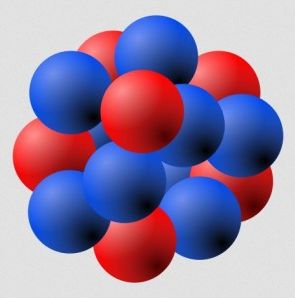
Modern chemistry depends a good deal upon accurately knowing the atomic mass of each of the elements. What factors complicate determining those values?
Each of the approximately 90 different natural-occurring elements possesses a nucleus or central core of protons and neutrons, in addition to electrons that orbit around the nucleus. It is important to the chemist or physicist to know the total mass of each element.
Can correct values be obtained simply by summing the weight of individual particles in an atom? After all, each of these particles has a precisely known mass. The answer is, No! Such calculations disagree with experimental measurement. An example illustrates the point.
Consider Helium-3
An atom of helium-3 has two protons, one neutron, and two electrons. The mass of these particles is 1.007276 amu (atomic mass units) per proton, 1.008665 amu per neutron, and 0.000549 amu per electron. One atom of He-3 should be 2.014520 amu + 1.008665 amu + 0.001098 amu, or a total of 3.024283 amu. In reality, He-3 has a mass of 3.016030 – a mass difference of 0.008253 amu. This difference is associated with the binding energy – the energy that bundles these particles together within the nucleus – and represents one complication associated with the determination of an accurate atomic mass.
Another Complication – Isotopes
Another complication is that most elements consist of combinations of isotopes, or different atoms of the element that have different masses! In the case of helium, such as is used to fill balloons, there is a helium-4 mixed in. Elements are defined by the number of protons contained within the nucleus. All atoms of any element have the same number of protons. The number of neutrons, however, can and do vary. Helium-4 consists of two protons, two neutrons, and two electrons. The mass of helium-4 is, naturally, greater than that of helium-3. Elements other than helium have multiple isotopes; tin has ten stable isotopes!
Accurately Determining Atomic Mass
Stories are rife about the search for the mythical “Holy Grail.” A real-life search nearly as difficult and taking many decades has been undertaken to determine the atomic masses of all the elements. Wet-test methods were used during the 19th and early 20th centuries. However, more fruitful and accurate results have been made since, utilizing the mass spectrometer. This device has been used to determine both the percentages of isotopes, as well as the mass of each.
Why Important
Chemistry is not just about what happens, but how compounds react. It is also important to know precisely the quantities that are involved, that is, the stoichiometry of a reaction. Too much or too little of a chemical could alter the course of a reaction, which can be dangerous, for example, in the manufacture of drugs, or in maintenance of a nuclear facility. Quantities are invariably derived from the molecular weight of a compound, the sum of the atomic weights of each atom.
Note: You might also enjoy Fission Energy Vs. Total Energy of Uranium-235
← Back to Classic Science
← Home